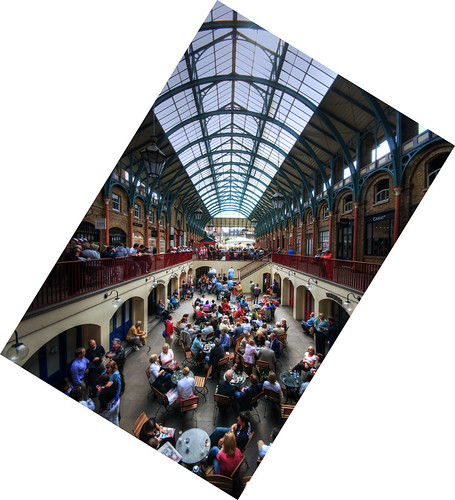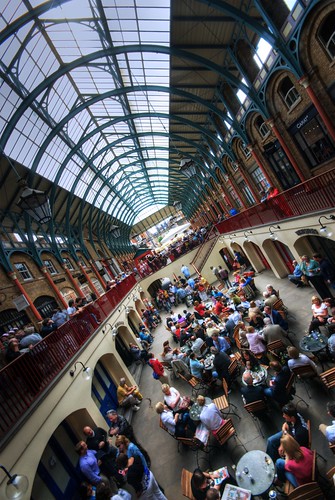
Here is the same image again from a tilted perspective.
Now those leading lines are all in a different configuration. The two bannisters still pull the eye towards the distance, but now we have the asymmetry that also is pulling on the eye. The brown brickwork and the glass roof make the top half a very contrasting part of the frame. I used this to create a powerful line because of this contrast - the eye is more taken by the glass roof which leads to the distance. The bottom left of the frame is aligned with the bannister to create a second line. To top it off the degree of tilt was determined by aligning the transistion at the top between the glass and the brickwork so that it formed a vertical line downwards. What this does is create an impression that the market hall could be longer than it is in real life because of the exaggerated lines. Now one example isn't enough, so here's another:
So the theme I hope I've established is that the tilt isn't something that can be haphazardly used. You need at least 2 leading lines, if not more, for this perspective to work strongly. It's preferable to have the centre of the frame as the point where these lines converge, though it doesn't have to be the case from time to time. Again I'll illustrate this.

Here is an image of St Pancras Railway Station. The leading lines from the bannister and roof are similar to the one above from Covent Garden but the tilt here is noticeably less and also to the other direction. You might be asking why - and that's down to the odd leading line of the escalator. This doesn't lead to the centre of the frame, but to the bottom third. What this can add is another line of interest to the image.
We've now identified what needs to be there for tilting - leading lines to a focal point. But how can we tell when is a good opportunity to tilt, and then how much to tilt it by?
The answer is simple - experience and interest. We view the world from a horizontal perspective; as photographers we seek different perspectives - hence the suggestions of lying low or climbing high for that difference from eye level. What we sometimes neglect is that at eye level we can also tilt for that difference. Composition doesn't have to follow the basic rule of thirds as we're manipulating converging lines instead. And it's the convergence that tells us the tilt. Strongly convergent lines like the market hall can give greater scope for tilting, whilst gentler lines as in the railway station accommodate for less.
In the end it comes down to experimentation. Often a little trial and error to find the right angle is needed, and to find that different perspective that we don't often see every day. Good luck!


2 comments:
I remember my first experience really photographing anything, it was in fact a wedding, and I was about 7. The groom (my uncle) gave me his digital camera, and said jake take pictures. I tilted every single one of them. He was a bit annoyed. :)
He just didn't appreciate the natural talent :)
Post a Comment